Seat Toledo 2013 Owner's manual
Manufacturer: SEAT, Model Year: 2013, Model line: Toledo, Model: Seat Toledo 2013Pages: 258, PDF Size: 3.94 MB
Page 171 of 258
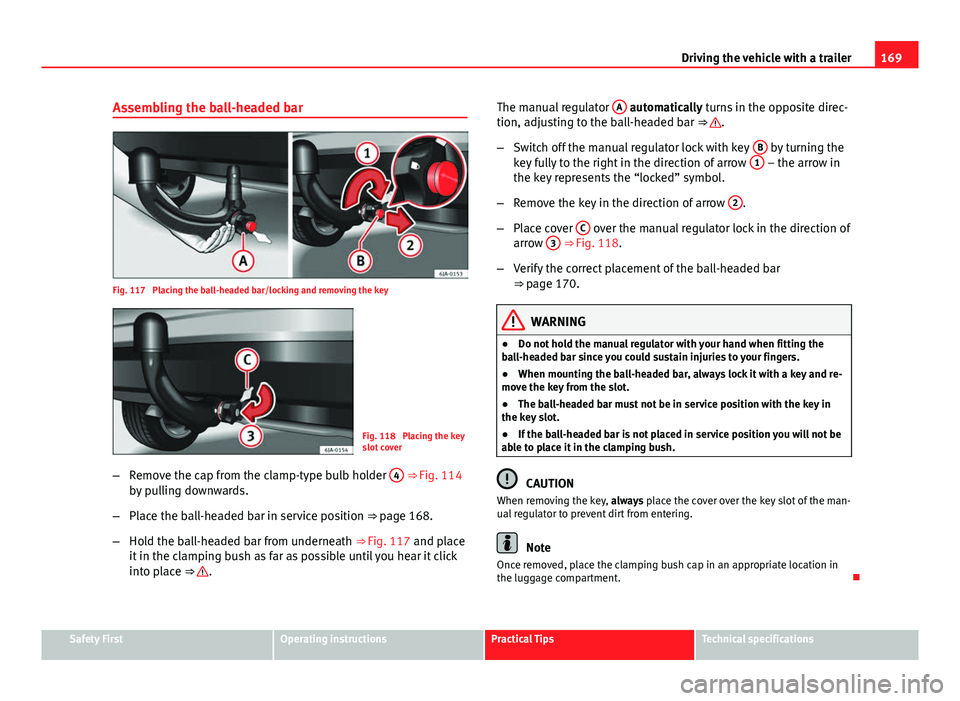
169
Driving the vehicle with a trailer
Assembling the ball-headed bar
Fig. 117 Placing the ball-headed bar/locking and removing the key
Fig. 118 Placing the key
slot cover
– Remove the cap from the clamp-type bulb holder 4
⇒ Fig. 114
by pulling downwards.
– Place the ball-headed bar in service position ⇒ page 168.
– Hold the ball-headed bar from underneath ⇒ Fig. 117 and place
it in the clamping bush as far as possible until you hear it click
into place ⇒
. The manual regulator
A
automatically turns in the opposite direc-
tion, adjusting to the ball-headed bar ⇒ .
– Switch off the manual regulator lock with key B
by turning the
key fully to the right in the direction of arrow 1 – the arrow in
the key represents the “locked” symbol.
– Remove the key in the direction of arrow 2
.
– Place cover C
over the manual regulator lock in the direction of
arrow 3 ⇒ Fig. 118.
– Verify the correct placement of the ball-headed bar
⇒ page 170.
WARNING
● Do not hold the manual regulator with your hand when fitting the
ball-headed bar since you could sustain injuries to your fingers.
● When mounting the ball-headed bar, always lock it with a key and re-
move the key from the slot.
● The ball-headed bar must not be in service position with the key in
the key slot.
● If the ball-headed bar is not placed in service position you will not be
able to place it in the clamping bush.
CAUTION
When removing the key, always place the cover over the key slot of the man-
ual regulator to prevent dirt from entering.
Note
Once removed, place the clamping bush cap in an appropriate location in
the luggage compartment.
Safety FirstOperating instructionsPractical TipsTechnical specifications
Page 172 of 258
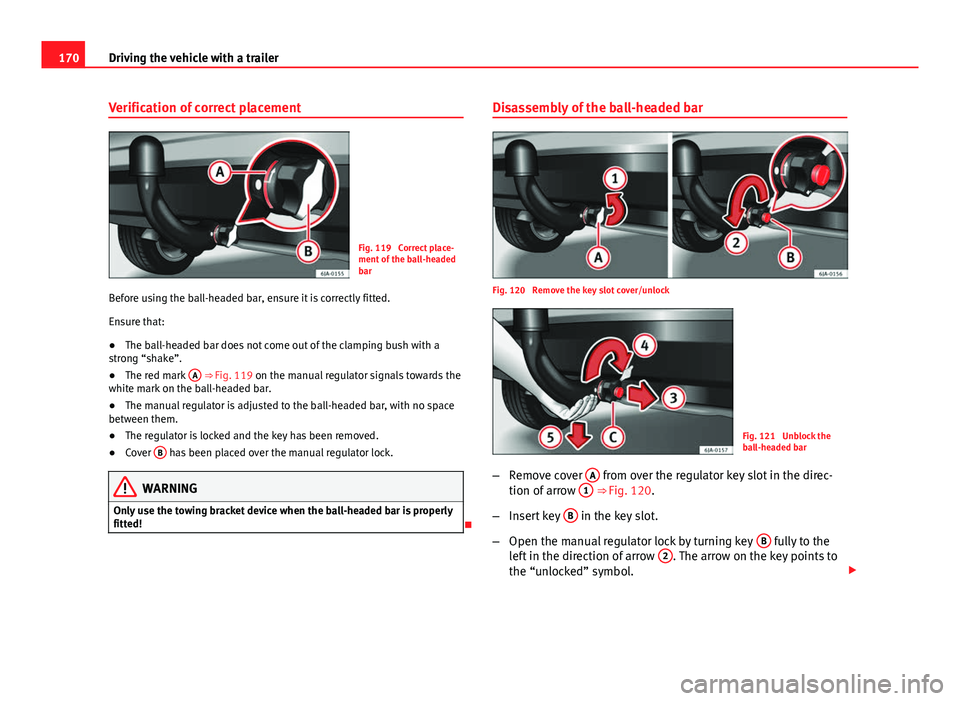
170Driving the vehicle with a trailer
Verification of correct placement
Fig. 119 Correct place-
ment of the ball-headed
bar
Before using the ball-headed bar, ensure it is correctly fitted.
Ensure that:
● The ball-headed bar does not come out of the clamping bush with a
strong “shake”.
● The red mark A
⇒ Fig. 119 on the manual regulator signals towards the
white mark on the ball-headed bar.
● The manual regulator is adjusted to the ball-headed bar, with no space
between them.
● The regulator is locked and the key has been removed.
● Cover B
has been placed over the manual regulator lock.
WARNING
Only use the towing bracket device when the ball-headed bar is properly
fitted!
Disassembly of the ball-headed bar
Fig. 120 Remove the key slot cover/unlock
Fig. 121 Unblock the
ball-headed bar
– Remove cover A
from over the regulator key slot in the direc-
tion of arrow 1 ⇒ Fig. 120.
– Insert key B
in the key slot.
– Open the manual regulator lock by turning key B
fully to the
left in the direction of arrow 2. The arrow on the key points to
the “unlocked” symbol.
Page 173 of 258
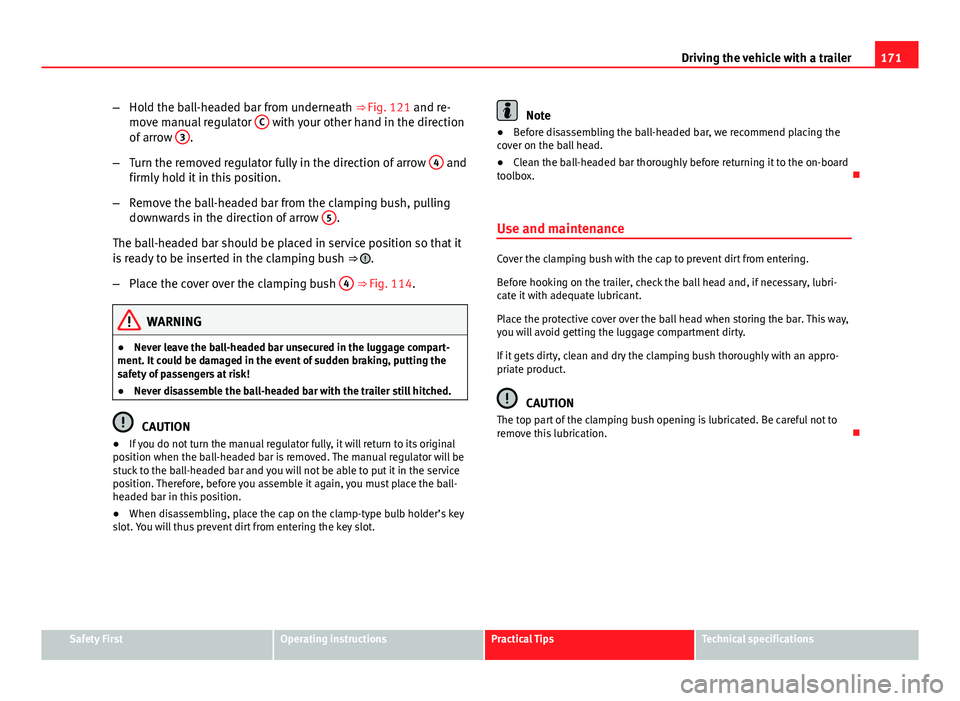
171
Driving the vehicle with a trailer
– Hold the ball-headed bar from underneath ⇒ Fig. 121 and re-
move manual regulator C
with your other hand in the direction
of arrow 3.
– Turn the removed regulator fully in the direction of arrow 4
and
firmly hold it in this position.
– Remove the ball-headed bar from the clamping bush, pulling
downwards in the direction of arrow 5
.
The ball-headed bar should be placed in service position so that it
is ready to be inserted in the clamping bush ⇒
.
– Place the cover over the clamping bush 4
⇒ Fig. 114.
WARNING
● Never leave the ball-headed bar unsecured in the luggage compart-
ment. It could be damaged in the event of sudden braking, putting the
safety of passengers at risk!
● Never disassemble the ball-headed bar with the trailer still hitched.
CAUTION
● If you do not turn the manual regulator fully, it will return to its original
position when the ball-headed bar is removed. The manual regulator will be
stuck to the ball-headed bar and you will not be able to put it in the service
position. Therefore, before you assemble it again, you must place the ball-
headed bar in this position.
● When disassembling, place the cap on the clamp-type bulb holder’s key
slot. You will thus prevent dirt from entering the key slot.
Note
● Before disassembling the ball-headed bar, we recommend placing the
cover on the ball head.
● Clean the ball-headed bar thoroughly before returning it to the on-board
toolbox.
Use and maintenance
Cover the clamping bush with the cap to prevent dirt from entering.
Before hooking on the trailer, check the ball head and, if necessary, lubri-
cate it with adequate lubricant.
Place the protective cover over the ball head when storing the bar. This way,
you will avoid getting the luggage compartment dirty.
If it gets dirty, clean and dry the clamping bush thoroughly with an appro-
priate product.
CAUTION
The top part of the clamping bush opening is lubricated. Be careful not to
remove this lubrication.
Safety FirstOperating instructionsPractical TipsTechnical specifications
Page 174 of 258

172Care of the vehicle and cleaning
Care of the vehicle and cleaning
Care of the vehicle
Introduction
Regular and suitable care helps to maintain the useful life of your vehicle.
This may also be one of the requirements for upholding any warranty claims
in the event of corrosion or paint defects.
We recommend you use cleaning products from the SEAT Original Accesso-
ries programme available in SEAT dealers. Please follow the instructions for
use on the packaging.
WARNING
● Cleaning products and other materials used for car care can damage
the health if misused.
● Always keep car care materials in a safe place out of the reach of chil-
dren. Risk of poisoning!
● When washing the car during the winter season: Moisture and ice on
the brakes may affect braking efficiency. Risk of accident!
● The ignition must always be switched off when the car is washed.
Risk of accident!
● Do not clean the underside of the car or inside the wheel arches with-
out protecting your hands and arms. You may cut yourself on sharp metal
parts!
● Perfumes and air fresheners inside the vehicle may be harmful to
health at high temperatures in the interior.
CAUTION
● Check the colour stability of your clothing to avoid damaging or visibly
staining the fabric (leather), upholstery and fabric trim.
● Cleaning products containing solvents may damage the material being
cleaned.
● Do not wash the vehicle in direct sunlight. Risk of damage to paintwork.
● If washing the vehicle with a hose in winter, do not direct the jet of water
directly at the locks or at the door seals or bonnet. Risk of freezing.
● Do not use insect sponges or abrasive household sponges, etc. on pain-
ted surfaces. Risk of damage to the painted surface.
● Do not put stickers on the inner side of the window in areas where heat-
ing elements or the aerial is located. This could cause damage and, in the
case of the aerial, radio and navigation system reception faults.
● Do not clean the inner side of the window with sharp objects or corro-
sive or acidic cleaning products. Risk of damaging the heating elements or
the aerial.
● Do not attach any fragrance or air freshener to the dash panel. Risk of
damage to the dash panel.
● To avoid damaging the parking aid system sensors, spray them only
briefly at a minimum distance of 10 cm when cleaning the vehicle with a
high-pressure or steam cleaner.
● Do not clean the roof panel with a brush. Risk of damage to the panel
surface!
For the sake of the environment
● The packaging of the product used to care for your vehicle is hazardous
waste. It must be disposed of according to current local law.
● Only wash the car in special wash bays.
Page 175 of 258
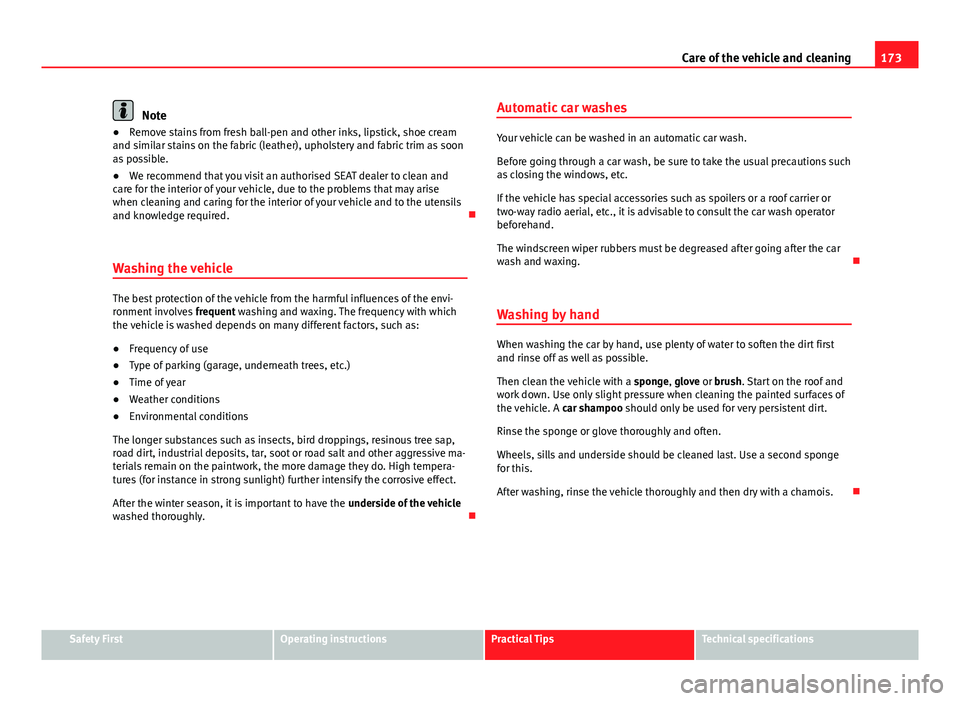
173
Care of the vehicle and cleaning
Note
● Remove stains from fresh ball-pen and other inks, lipstick, shoe cream
and similar stains on the fabric (leather), upholstery and fabric trim as soon
as possible.
● We recommend that you visit an authorised SEAT dealer to clean and
care for the interior of your vehicle, due to the problems that may arise
when cleaning and caring for the interior of your vehicle and to the utensils
and knowledge required.
Washing the vehicle
The best protection of the vehicle from the harmful influences of the envi-
ronment involves frequent washing and waxing. The frequency with which
the vehicle is washed depends on many different factors, such as:
● Frequency of use
● Type of parking (garage, underneath trees, etc.)
● Time of year
● Weather conditions
● Environmental conditions
The longer substances such as insects, bird droppings, resinous tree sap,
road dirt, industrial deposits, tar, soot or road salt and other aggressive ma-
terials remain on the paintwork, the more damage they do. High tempera-
tures (for instance in strong sunlight) further intensify the corrosive effect.
After the winter season, it is important to have the underside of the vehicle
washed thoroughly. Automatic car washes
Your vehicle can be washed in an automatic car wash.
Before going through a car wash, be sure to take the usual precautions such
as closing the windows, etc.
If the vehicle has special accessories such as spoilers or a roof carrier or
two-way radio aerial, etc., it is advisable to consult the car wash operator
beforehand.
The windscreen wiper rubbers must be degreased after going after the car
wash and waxing.
Washing by hand
When washing the car by hand, use plenty of water to soften the dirt first
and rinse off as well as possible.
Then clean the vehicle with a sponge, glove or brush. Start on the roof and
work down. Use only slight pressure when cleaning the painted surfaces of
the vehicle. A car shampoo should only be used for very persistent dirt.
Rinse the sponge or glove thoroughly and often.
Wheels, sills and underside should be cleaned last. Use a second sponge
for this.
After washing, rinse the vehicle thoroughly and then dry with a chamois.
Safety FirstOperating instructionsPractical TipsTechnical specifications
Page 176 of 258
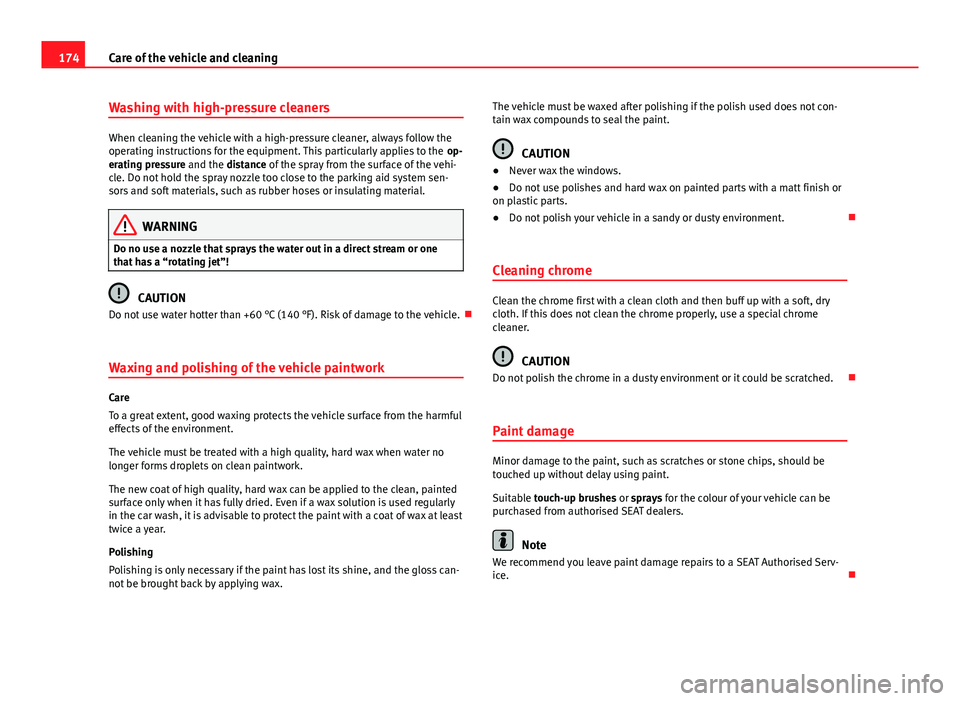
174Care of the vehicle and cleaning
Washing with high-pressure cleaners
When cleaning the vehicle with a high-pressure cleaner, always follow the
operating instructions for the equipment. This particularly applies to the op-
erating pressure and the distance of the spray from the surface of the vehi-
cle. Do not hold the spray nozzle too close to the parking aid system sen-
sors and soft materials, such as rubber hoses or insulating material.
WARNING
Do no use a nozzle that sprays the water out in a direct stream or one
that has a “rotating jet”!
CAUTION
Do not use water hotter than +60 °C (140 °F). Risk of damage to the vehicle.
Waxing and polishing of the vehicle paintwork
Care
To a great extent, good waxing protects the vehicle surface from the harmful
effects of the environment.
The vehicle must be treated with a high quality, hard wax when water no
longer forms droplets on clean paintwork.
The new coat of high quality, hard wax can be applied to the clean, painted
surface only when it has fully dried. Even if a wax solution is used regularly
in the car wash, it is advisable to protect the paint with a coat of wax at least
twice a year.
Polishing
Polishing is only necessary if the paint has lost its shine, and the gloss can-
not be brought back by applying wax. The vehicle must be waxed after polishing if the polish used does not con-
tain wax compounds to seal the paint.
CAUTION
● Never wax the windows.
● Do not use polishes and hard wax on painted parts with a matt finish or
on plastic parts.
● Do not polish your vehicle in a sandy or dusty environment.
Cleaning chrome
Clean the chrome first with a clean cloth and then buff up with a soft, dry
cloth. If this does not clean the chrome properly, use a special chrome
cleaner.
CAUTION
Do not polish the chrome in a dusty environment or it could be scratched.
Paint damage
Minor damage to the paint, such as scratches or stone chips, should be
touched up without delay using paint.
Suitable touch-up brushes or sprays for the colour of your vehicle can be
purchased from authorised SEAT dealers.
Note
We recommend you leave paint damage repairs to a SEAT Authorised Serv-
ice.
Page 177 of 258
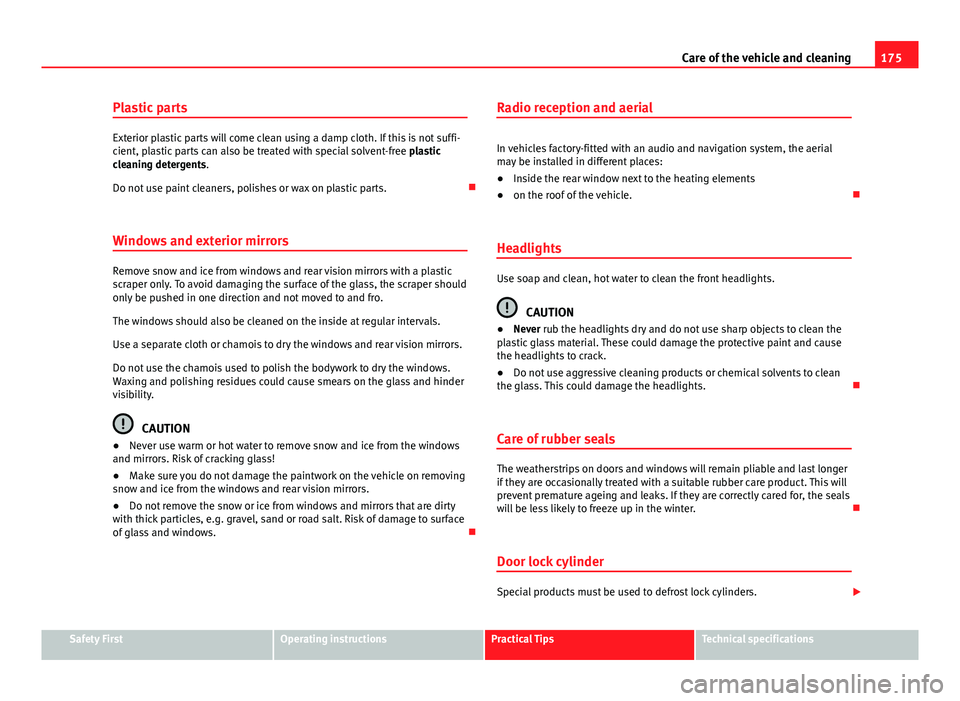
175
Care of the vehicle and cleaning
Plastic parts
Exterior plastic parts will come clean using a damp cloth. If this is not suffi-
cient, plastic parts can also be treated with special solvent-free plastic
cleaning detergents.
Do not use paint cleaners, polishes or wax on plastic parts.
Windows and exterior mirrors
Remove snow and ice from windows and rear vision mirrors with a plastic
scraper only. To avoid damaging the surface of the glass, the scraper should
only be pushed in one direction and not moved to and fro.
The windows should also be cleaned on the inside at regular intervals.
Use a separate cloth or chamois to dry the windows and rear vision mirrors.
Do not use the chamois used to polish the bodywork to dry the windows.
Waxing and polishing residues could cause smears on the glass and hinder
visibility.
CAUTION
● Never use warm or hot water to remove snow and ice from the windows
and mirrors. Risk of cracking glass!
● Make sure you do not damage the paintwork on the vehicle on removing
snow and ice from the windows and rear vision mirrors.
● Do not remove the snow or ice from windows and mirrors that are dirty
with thick particles, e.g. gravel, sand or road salt. Risk of damage to surface
of glass and windows. Radio reception and aerial
In vehicles factory-fitted with an audio and navigation system, the aerial
may be installed in different places:
●
Inside the rear window next to the heating elements
● on the roof of the vehicle.
Headlights
Use soap and clean, hot water to clean the front headlights.
CAUTION
● Never rub the headlights dry and do not use sharp objects to clean the
plastic glass material. These could damage the protective paint and cause
the headlights to crack.
● Do not use aggressive cleaning products or chemical solvents to clean
the glass. This could damage the headlights.
Care of rubber seals
The weatherstrips on doors and windows will remain pliable and last longer
if they are occasionally treated with a suitable rubber care product. This will
prevent premature ageing and leaks. If they are correctly cared for, the seals
will be less likely to freeze up in the winter.
Door lock cylinder
Special products must be used to defrost lock cylinders.
Safety FirstOperating instructionsPractical TipsTechnical specifications
Page 178 of 258
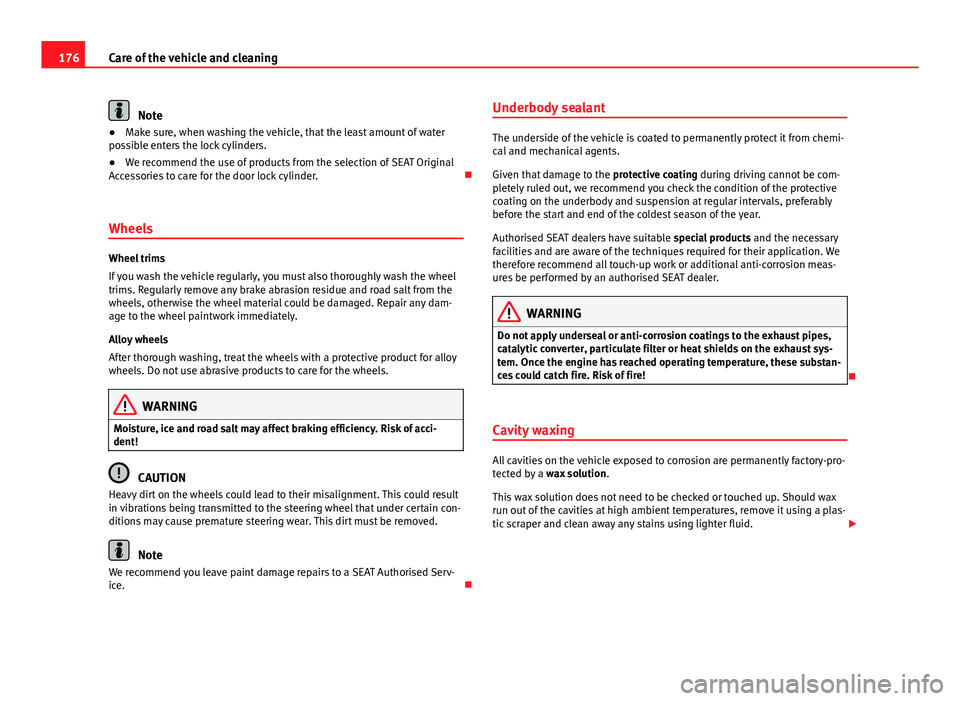
176Care of the vehicle and cleaning
Note
● Make sure, when washing the vehicle, that the least amount of water
possible enters the lock cylinders.
● We recommend the use of products from the selection of SEAT Original
Accessories to care for the door lock cylinder.
Wheels
Wheel trims
If you wash the vehicle regularly, you must also thoroughly wash the wheel
trims. Regularly remove any brake abrasion residue and road salt from the
wheels, otherwise the wheel material could be damaged. Repair any dam-
age to the wheel paintwork immediately.
Alloy wheels
After thorough washing, treat the wheels with a protective product for alloy
wheels. Do not use abrasive products to care for the wheels.
WARNING
Moisture, ice and road salt may affect braking efficiency. Risk of acci-
dent!
CAUTION
Heavy dirt on the wheels could lead to their misalignment. This could result
in vibrations being transmitted to the steering wheel that under certain con-
ditions may cause premature steering wear. This dirt must be removed.
Note
We recommend you leave paint damage repairs to a SEAT Authorised Serv-
ice. Underbody sealant
The underside of the vehicle is coated to permanently protect it from chemi-
cal and mechanical agents.
Given that damage to the
protective coating during driving cannot be com-
pletely ruled out, we recommend you check the condition of the protective
coating on the underbody and suspension at regular intervals, preferably
before the start and end of the coldest season of the year.
Authorised SEAT dealers have suitable special products and the necessary
facilities and are aware of the techniques required for their application. We
therefore recommend all touch-up work or additional anti-corrosion meas-
ures be performed by an authorised SEAT dealer.
WARNING
Do not apply underseal or anti-corrosion coatings to the exhaust pipes,
catalytic converter, particulate filter or heat shields on the exhaust sys-
tem. Once the engine has reached operating temperature, these substan-
ces could catch fire. Risk of fire!
Cavity waxing
All cavities on the vehicle exposed to corrosion are permanently factory-pro-
tected by a wax solution .
This wax solution does not need to be checked or touched up. Should wax
run out of the cavities at high ambient temperatures, remove it using a plas-
tic scraper and clean away any stains using lighter fluid.
Page 179 of 258
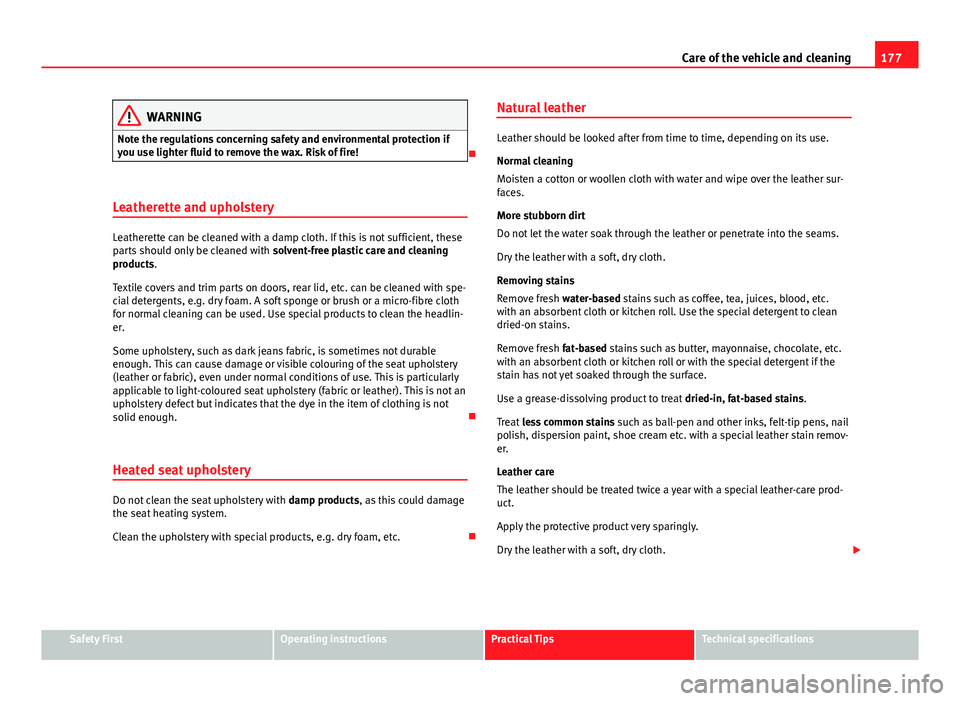
177
Care of the vehicle and cleaning
WARNING
Note the regulations concerning safety and environmental protection if
you use lighter fluid to remove the wax. Risk of fire!
Leatherette and upholstery
Leatherette can be cleaned with a damp cloth. If this is not sufficient, these
parts should only be cleaned with solvent-free plastic care and cleaning
products.
Textile covers and trim parts on doors, rear lid, etc. can be cleaned with spe-
cial detergents, e.g. dry foam. A soft sponge or brush or a micro-fibre cloth
for normal cleaning can be used. Use special products to clean the headlin-
er.
Some upholstery, such as dark jeans fabric, is sometimes not durable
enough. This can cause damage or visible colouring of the seat upholstery
(leather or fabric), even under normal conditions of use. This is particularly
applicable to light-coloured seat upholstery (fabric or leather). This is not an
upholstery defect but indicates that the dye in the item of clothing is not
solid enough.
Heated seat upholstery
Do not clean the seat upholstery with damp products, as this could damage
the seat heating system.
Clean the upholstery with special products, e.g. dry foam, etc. Natural leather
Leather should be looked after from time to time, depending on its use.
Normal cleaning
Moisten a cotton or woollen cloth with water and wipe over the leather sur-
faces.
More stubborn dirt
Do not let the water soak through the leather or penetrate into the seams.
Dry the leather with a soft, dry cloth.
Removing stains
Remove fresh water-based stains such as coffee, tea, juices, blood, etc.
with an absorbent cloth or kitchen roll. Use the special detergent to clean
dried-on stains.
Remove fresh fat-based stains such as butter, mayonnaise, chocolate, etc.
with an absorbent cloth or kitchen roll or with the special detergent if the
stain has not yet soaked through the surface.
Use a grease-dissolving product to treat
dried-in, fat-based stains.
Treat less common stains such as ball-pen and other inks, felt-tip pens, nail
polish, dispersion paint, shoe cream etc. with a special leather stain remov-
er.
Leather care
The leather should be treated twice a year with a special leather-care prod-
uct.
Apply the protective product very sparingly.
Dry the leather with a soft, dry cloth.
Safety FirstOperating instructionsPractical TipsTechnical specifications
Page 180 of 258
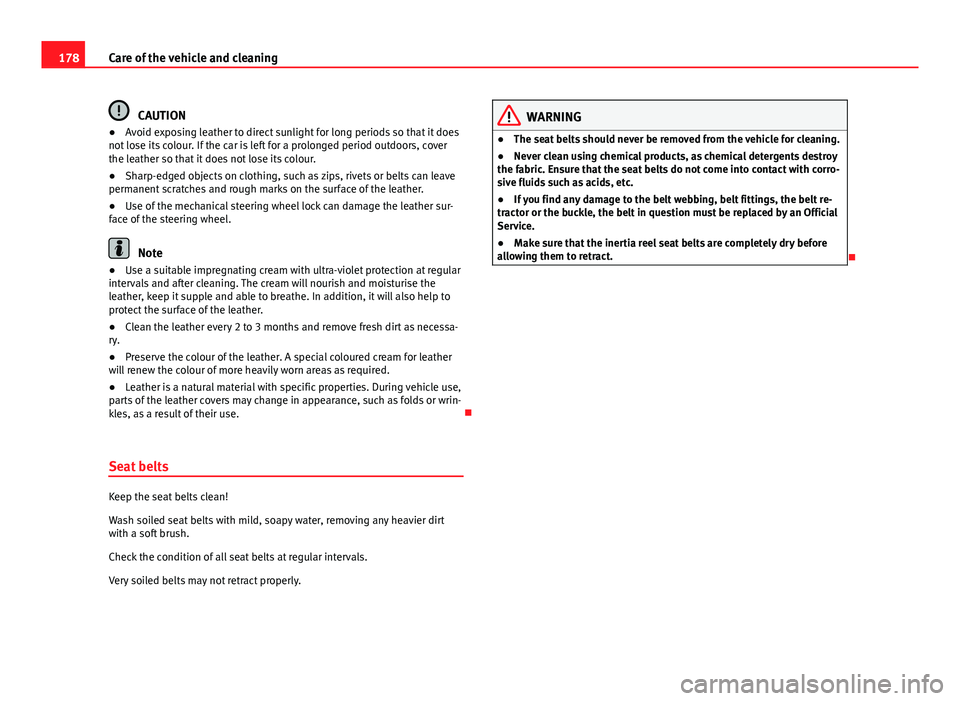
178Care of the vehicle and cleaning
CAUTION
● Avoid exposing leather to direct sunlight for long periods so that it does
not lose its colour. If the car is left for a prolonged period outdoors, cover
the leather so that it does not lose its colour.
● Sharp-edged objects on clothing, such as zips, rivets or belts can leave
permanent scratches and rough marks on the surface of the leather.
● Use of the mechanical steering wheel lock can damage the leather sur-
face of the steering wheel.
Note
● Use a suitable impregnating cream with ultra-violet protection at regular
intervals and after cleaning. The cream will nourish and moisturise the
leather, keep it supple and able to breathe. In addition, it will also help to
protect the surface of the leather.
● Clean the leather every 2 to 3 months and remove fresh dirt as necessa-
ry.
● Preserve the colour of the leather. A special coloured cream for leather
will renew the colour of more heavily worn areas as required.
● Leather is a natural material with specific properties. During vehicle use,
parts of the leather covers may change in appearance, such as folds or wrin-
kles, as a result of their use.
Seat belts
Keep the seat belts clean!
Wash soiled seat belts with mild, soapy water, removing any heavier dirt
with a soft brush.
Check the condition of all seat belts at regular intervals.
Very soiled belts may not retract properly.
WARNING
● The seat belts should never be removed from the vehicle for cleaning.
● Never clean using chemical products, as chemical detergents destroy
the fabric. Ensure that the seat belts do not come into contact with corro-
sive fluids such as acids, etc.
● If you find any damage to the belt webbing, belt fittings, the belt re-
tractor or the buckle, the belt in question must be replaced by an Official
Service.
● Make sure that the inertia reel seat belts are completely dry before
allowing them to retract.